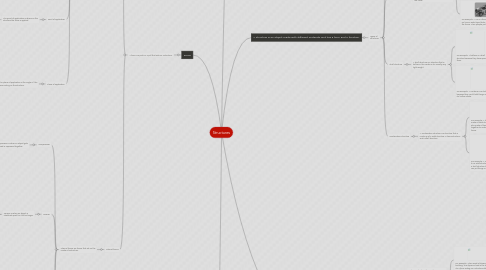
1. Force
1.1. A force is a push or a pull that acts on a sturcture.
1.1.1. External forces
1.1.1.1. External forces are forces that act on the outside of an object.
1.1.1.1.1. Gravity
1.1.1.1.2. Wind
1.1.1.2. Application of External forces
1.1.1.2.1. Magnitude
1.1.1.2.2. Direction
1.1.1.2.3. Point of application
1.1.1.2.4. Plane of application
1.1.2. Internal forces
1.1.2.1. Internal forces are forces that act on the inside of a structure.
1.1.2.1.1. Compression
1.1.2.1.2. Tension
1.1.2.1.3. Torsion
1.1.2.1.4. Shear
2. Centre of gravity
2.1. The centre of gravity is where all the mass is located on a structure.
2.1.1. For example: If a person bends down, the centre of gravity somewhere near your back because all the weight or mass is located there.
2.1.2. For example: When a giraffe is standing up to eat leaves from a tree, the centre of gravity is near the back and the neck which is where all the mass is located.
2.1.3. Wherever the centre of gravity is on a structure determines how stable it is.
2.1.3.1. The lower the centre of gravity is, the more stable the structure is. So if the structure has a heavier and wider base, and a lighter top, the centre of gravity will be somewhere near the bottom of the structure, which helps the structure become more stable.
2.1.3.1.1. For example: The Eiffel Tower. It has a really wide base and a narrow top, which means the centre of gravity is lower and it makes the structure more stable.
2.1.3.1.2. For example: A giraffe is really stable even if it has a really long neck because it has a wide and heavy base which lowers the centre of gravity, and helps the giraffe be more stable and stand without falling over.
3. Real life structures
3.1. CN tower
3.1.1. The form of the CN tower is a tall and narrow building. the base is slightly wider, and the top is very narrow.
3.1.2. The function of this tower is for tourist attractions in Toronto. It has a restaurant inside, and a glass floor at the top of the building for people to look down at the city.
3.2. Eiffel tower
3.2.1. The form of the Eiffel Tower is a tall triangular tower with a wide base and a narrow top.
3.2.2. The function of this structure is mostly for tourists attractions in Paris.
3.3. Pyramid
3.3.1. The form of a pyramid is a triangular prism shaped structure that has a very wide base and a small point at the top, and it becomes only slightly more narrow as it goes up.
3.3.2. The function of a pyramid is a tomb for pharaohs and queens a really long time ago in Egypt.
4. A structure is an object made with different materials and has a form and a function.
4.1. Types of structures
4.1.1. Solid Structure
4.1.1.1. A solid structure is a structure that's made of solid materials. That's why it could be very sturdy, but very heavy at the same time.
4.1.1.1.1. For example: An apple is a type of solid structure because it's solid on the inside and it's pretty sturdy.
4.1.1.1.2. For example: A mountain is a solid structure because it's made of solid material and it's solid inside, meaning that it's not hollow.
4.1.2. Frame Structure
4.1.2.1. A frame structure is a structure that has parts that are fastened together to support the cover.
4.1.2.1.1. For example: An umbrella is a frame structure because they have strong rods fastened together to support the claim that bed of the umbrella.
4.1.2.1.2. For example: A car is a frame structure because a car has an extra layer that's really sturdy which is the frame. Then people put the cover on top.
4.1.3. Shell Structure
4.1.3.1. A shell structure is a structure that is hollow in the inside so it's usually very light weight.
4.1.3.1.1. For example: A balloon is a shell structure because they have space inside them.
4.1.3.1.2. For example: A container is a shell structure because they could hold things inside them, and it's hollow inside.
4.1.4. Combination Structure
4.1.4.1. A combination structure is a structure that is made up of a solid structure, a frame structure, and a shell structure.
4.1.4.1.1. For example: A house is a combination structure because it's made of solid structures like the wood, bricks, and nails. They're also made of frame structures because the wood are nailed together to make a frame. Then the walls and the roof cover the frame.
4.1.4.1.2. For example: A computer desk is a combination structure because it's a solid structure since it's made of solid material, and it's also a shell structure because there's a place where it's hollow and you can put things in.
5. Load
5.1. Load is a force that acts on a structure.
5.1.1. Dynamic load
5.1.1.1. A dynamic load is a force acting on a structure that could move or change when it's acting on a structure. It is also another force acting on a structure other than gravity.
5.1.1.1.1. For example: When wind is blowing on a building. The dynamic load is the wind because it's a force acting on a structure other than gravity,
5.1.1.1.2. For example: A running shoe when it's about to hit the ground. The dynamic load is the ground because it's another force that acts on the shoe other than gravity.
5.1.2. Static load
5.1.2.1. A static load is a load that acts on a structure that is affected by gravity.
5.1.2.1.1. Live load
5.1.2.1.2. Dead load
